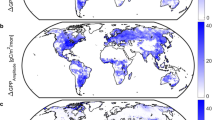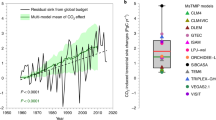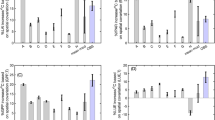Abstract
Uncertainties in the response of vegetation to rising atmospheric CO2 concentrations1,2 contribute to the large spread in projections of future climate change3,4. Climate–carbon cycle models generally agree that elevated atmospheric CO2 concentrations will enhance terrestrial gross primary productivity (GPP). However, the magnitude of this CO2 fertilization effect varies from a 20 per cent to a 60 per cent increase in GPP for a doubling of atmospheric CO2 concentrations in model studies5,6,7. Here we demonstrate emergent constraints8,9,10,11 on large-scale CO2 fertilization using observed changes in the amplitude of the atmospheric CO2 seasonal cycle that are thought to be the result of increasing terrestrial GPP12,13,14. Our comparison of atmospheric CO2 measurements from Point Barrow in Alaska and Cape Kumukahi in Hawaii with historical simulations of the latest climate–carbon cycle models demonstrates that the increase in the amplitude of the CO2 seasonal cycle at both measurement sites is consistent with increasing annual mean GPP, driven in part by climate warming, but with differences in CO2 fertilization controlling the spread among the model trends. As a result, the relationship between the amplitude of the CO2 seasonal cycle and the magnitude of CO2 fertilization of GPP is almost linear across the entire ensemble of models. When combined with the observed trends in the seasonal CO2 amplitude, these relationships lead to consistent emergent constraints on the CO2 fertilization of GPP. Overall, we estimate a GPP increase of 37 ± 9 per cent for high-latitude ecosystems and 32 ± 9 per cent for extratropical ecosystems under a doubling of atmospheric CO2 concentrations on the basis of the Point Barrow and Cape Kumukahi records, respectively.
This is a preview of subscription content, access via your institution
Access options
Subscribe to this journal
Receive 51 print issues and online access
$199.00 per year
only $3.90 per issue
Buy this article
- Purchase on Springer Link
- Instant access to full article PDF
Prices may be subject to local taxes which are calculated during checkout



Similar content being viewed by others
References
Norby, R. J. et al. Forest response to elevated CO2 is conserved across a broad range of productivity. Proc. Natl Acad. Sci. USA 102, 18052–18056 (2005)
Leakey, A. D. B. et al. Elevated CO2 effects on plant carbon, nitrogen, and water relations: six important lessons from FACE. J. Exp. Bot. 60, 2859–2876 (2009)
Friedlingstein, P. et al. Climate–carbon cycle feedback analysis: results from the C4MIP model intercomparison. J. Clim. 19, 3337–3353 (2006)
Ciais, P. et al. in Climate Change 2013: the Physical Science Basis (eds Stocker, T. F. et al. ) 465–570 (IPCC, Cambridge Univ. Press, 2013)
Anav, A. et al. Evaluating the land and ocean components of the global carbon cycle in the CMIP5 earth system models. J. Clim. 26, 6801–6843 (2013)
Piao, S. et al. Evaluation of terrestrial carbon cycle models for their response to climate variability and to CO2 trends. Glob. Chang. Biol. 19, 2117–2132 (2013)
Friedlingstein, P. et al. Uncertainties in CMIP5 climate projections due to carbon cycle feedbacks. J. Clim. 27, 511–526 (2014)
Allen, M. R. & Ingram, W. J. Constraints on future changes in climate and the hydrologic cycle. Nature 419, 224–232 (2002)
Hall, A. & Qu, X. Using the current seasonal cycle to constrain snow albedo feedback in future climate change. Geophys. Res. Lett. 33, L03502 (2006)
Cox, P. M. et al. Sensitivity of tropical carbon to climate change constrained by carbon dioxide variability. Nature 494, 341–344 (2013)
Wenzel, S., Cox, P. M., Eyring, V. & Friedlingstein, P. Emergent constraints on climate-carbon cycle feedbacks in the CMIP5 Earth system models. J. Geophys. Res. Biogeosci. 119, 794–807 (2014)
Keeling, C. D., Chin, J. F. S. & Whorf, T. P. Increased activity of northern vegetation inferred from atmospheric CO2 measurements. Nature 382, 146–149 (1996)
Zhao, F. & Zeng, N. Continued increase in atmospheric CO2 seasonal amplitude in the 21st century projected by the CMIP5 Earth system models. Earth Syst. Dynam. 5, 423–439 (2014)
Gray, J. M. et al. Direct human influence on atmospheric CO2 seasonality from increased cropland productivity. Nature 515, 398–401 (2014)
Graven, H. D. et al. Enhanced seasonal exchange of CO2 by northern ecosystems since 1960. Science 341, 1085–1089 (2013)
Keeling, C., Whorf, T., Wahlen, M. & Plicht, J. Interannual extremes in the rate of rise of atmospheric carbon dioxide since 1980. Nature 375, 666–670 (1995)
Piao, S. et al. Net carbon dioxide losses of northern ecosystems in response to autumn warming. Nature 451, 49–52 (2008)
Taylor, K. E., Stouffer, R. J. & Meehl, G. A. An overview of CMIP5 and the experiment design. Bull. Am. Meteorol. Soc. 93, 485–498 (2012)
Eyring, V. et al. ESMValTool (v1.0) – a community diagnostic and performance metrics tool for routine evaluation of Earth system models in CMIP. Geosci. Model Dev. 9, 1747–1802 (2016)
Acknowledgements
This work was funded by the Horizon 2020 European Union’s Framework Programme for Research and Innovation under Grant Agreement No. 641816, the Coordinated Research in Earth Systems and Climate: Experiments, kNowledge, Dissemination and Outreach (CRESCENDO) project and the DLR Klimarelevanz von atmosphärischen Spurengasen, Aerosolen und Wolken: Auf dem Weg zu EarthCARE und MERLIN (KliSAW) project. We acknowledge the World Climate Research Programme (WCRP) Working Group on Coupled Modelling (WGCM), which is responsible for CMIP, and we thank the climate modelling groups for producing and making available their model output. For CMIP the US Department of Energy’s Program for Climate Model Diagnosis and Intercomparison provides coordinating support and led the development of software infrastructure in partnership with the Global Organization for Earth System Science Portals. We thank ETH Zurich for help in accessing data from the ESGF archive.
Author information
Authors and Affiliations
Contributions
S.W. led the study and analysis and drafted the manuscript with support from P.M.C. V.E. and P.F. contributed to the concept of the paper and the interpretation of the results. All co-authors commented on and provided edits to the original manuscript.
Corresponding author
Ethics declarations
Competing interests
The authors declare no competing financial interests.
Additional information
Reviewer Information
Nature thanks V. Brovkin and the other anonymous reviewer(s) for their contribution to the peer review of this work.
Extended data figures and tables
Extended Data Figure 1 Simulated and observed CO2 concentrations.
a, b, Time series of monthly mean atmospheric CO2 between 1860 and 2005 at BRW (a) and KMK (b) at surface level, as simulated by the CMIP5 models in the historical simulations and observed (black lines) at each measuring site.
Extended Data Figure 2 Annual mean high-latitude GPP (60° N–90° N) against the amplitude of the CO2 seasonal cycle at BRW for each of the CMIP5 ESMs.
The markers show the values for the individual years between 1850 and 2005 for the CMIP5 historical simulations and lines show the linear best fit for each model. The black line indicates the multi-model mean of the CMIP5 models.
Extended Data Figure 3 Comparison of high-latitude GPP (60° N–90° N) versus annual mean CO2.
a, The correlation for both the historical (asterisks) and the 1%BGC (circles) CMIP5 model simulations. The markers show the values for the individual years and lines show the linear best fit for each model. b, The comparison of the gradients in a for each model. The red solid line shows the gradient of the correlation and the black dashed line indicates a 1:1 correlation.
Rights and permissions
About this article
Cite this article
Wenzel, S., Cox, P., Eyring, V. et al. Projected land photosynthesis constrained by changes in the seasonal cycle of atmospheric CO2. Nature 538, 499–501 (2016). https://doi.org/10.1038/nature19772
Received:
Accepted:
Published:
Issue Date:
DOI: https://doi.org/10.1038/nature19772
This article is cited by
-
An emergent constraint on the thermal sensitivity of photosynthesis and greenness in the high latitude northern forests
Scientific Reports (2024)
-
Constrained tropical land temperature-precipitation sensitivity reveals decreasing evapotranspiration and faster vegetation greening in CMIP6 projections
npj Climate and Atmospheric Science (2023)
-
Spatial Inhomogeneity of Atmospheric CO2 Concentration and Its Uncertainty in CMIP6 Earth System Models
Advances in Atmospheric Sciences (2023)
-
Field-based tree mortality constraint reduces estimates of model-projected forest carbon sinks
Nature Communications (2022)
-
Stratification constrains future heat and carbon uptake in the Southern Ocean between 30°S and 55°S
Nature Communications (2022)
Comments
By submitting a comment you agree to abide by our Terms and Community Guidelines. If you find something abusive or that does not comply with our terms or guidelines please flag it as inappropriate.



